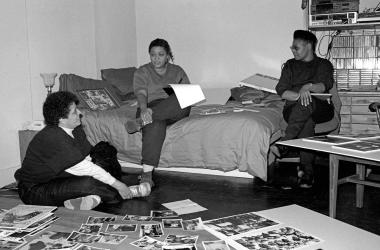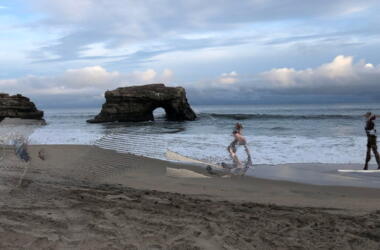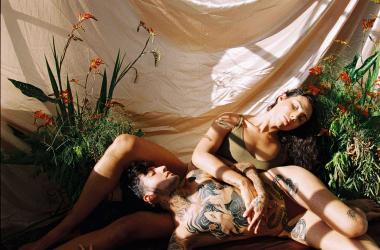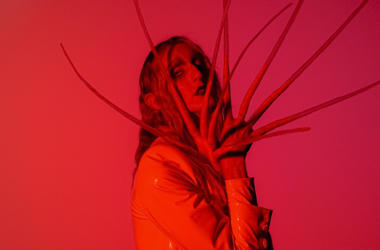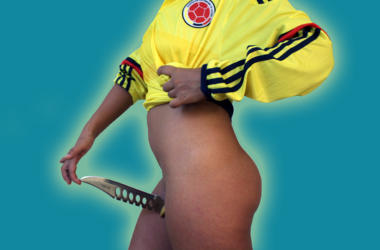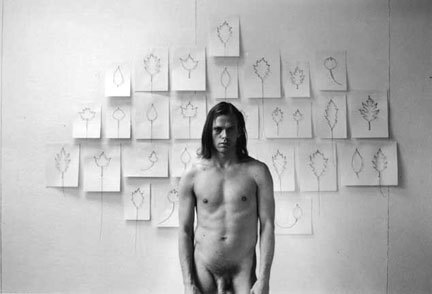
Image
ERIC RHEIN Portrait with Kinsmen (Self-Portrait), 1996 B/W photograph 8 x 10"
PAST
ERIC RHEIN: A Journey Among Warriors
Nov 07, 2006 - Dec 21, 2006
Eric Rhein The Fine Art of Remembering
By Michael Von Uchtrup
From THE ARCHIVE: No. 21: Autumn 2006
As he forms them, the birds in Eric Rhein’s hands seem to want to spring spontaneously into flight. Life-sized, life-like, they hover between drawing and sculpture, presence and absence, the real and the remembered. They are but lengths of bent wire—a series of gestures frozen in time, little more than shadows; it’s the empty space within each fine outline that is its essence.
When he looks up at me from his work, his expression is that of one whose mind is, at this moment, only partly in the present. But then, Rhein spent his boyhood here, in the mountains near New Paltz, New York, in this house. The hummingbird he has just finished is one of a series of finely crafted renderings of these graceful, ephemeral creatures; it has, like most things he makes, several layers of associations. “When someone dies,” Rhein once wrote to me, “it is said that their body weighs 21 grams less then it did when they were alive—the weight of a hummingbird.” Just beyond the window nature is bold and vigorous, and this timeless landscape is, unsurprisingly, one of the artist’s continuing influences. While Rhein now lives and works in Manhattan, the call to leave the city overtakes him often, and then suddenly he is collecting acorns, leaves, objects of all sorts, with a childlike enthusiasm.
The East Village studio in which he works has the air of an old-fashioned laboratory. It’s here that Rhein creates his assemblages of beads, crystals, bottle caps, gears, and other bits of detritus. Pages from books, sometimes with illustrations but often the blank endpapers; pieces of jewelry, items which once were in intimate proximity to somebody. Like the syllables in a haiku, they are assembled into delicate but stirring compositions, often deceptively simple in their appearance but charged with the big universal themes of sexuality, mortality, longing, and loss.
“I remember waking in my youth from dreams in which I had been drawn out into the night by spirits who were summoning me to rituals in the forests behind our house,” Rhein tells me. “I have no distinct memories of what I engaged in, but the feelings afterward were mystical and sexual, as if some rite of passage or initiation had been performed.” Those sensations, and Rhein’s subsequent experiences, would later manifest themselves in a body of work in which pleasure flirts with mystery and danger. His phallic portraits wrought from wire; the exoskeletal figures, looking like suits of armor; the virile half-men-half-creatures—all afford intimate glimpses into Rhein’s intriguing private mythology. In 1997, Holland Cotter wrote in The New York Times that Rhein’s work, “is, as it should be, seductive but disturbing.”
Another of Rhein’s continuing influences is his uncle, Elijah “Lige” Clarke (b. 1942), a former U.S. Army private assigned to the Pentagon who became a pioneer, along with his lover Jack Nichols, in the gay rights movement. Clarke helped organize the first White House protest march in 1965; he and Nichols published America’s first weekly gay newspaper from 1969 to 1973, were co-founders of Washington’s Mattachine Society, and co-authored two books, including the now-classic, I Have More Fun with You Than with Anybody. He was inexplicably ambushed and killed while traveling in Mexico in 1975, when Eric was 13.
As deeply as Lige Clarke’s life was affected by the gay rights struggle, a generation later his community’s next great challenge would alter that of his nephew even more: diagnosed with HIV in 1987 at age 27, the next decade brought Rhein closer to death than I care to know; then the protease inhibitor therapy he started in February of 1996 eventually brought about a breathtaking return to health. Those events—and the loss of friends and lovers who were not as fortunate—are often given a voice in Rhein’s sculpture, even when they are not its subject, and the parallel between his uncle’s activism and his own is not lost on Rhein. “I realize it was through my uncle’s influence that I have included themes of HIV and AIDS, as a form of activism, in my work,” Rhein once declared.
“I feel his presence even still as a guardian spirit,” he muses, something I have heard him say about his grandmother Corinne and others. The urge to stay connected, to remember and memorialize acquaintances and loved ones alike, is evident everywhere in Rhein’s work. In October of 1996, during a residency at New Hampshire’s MacDowell Colony, the ongoing Leaf Project was conceived. Each of the wire drawings in the series is, as the name implies, a rendering of a leaf; one actual fallen autumn leaf, it turns out, which reminds Rhein in some way of yet another person he knew who has succumbed to AIDS. With characteristic understatement, his exquisite empty spaces—and the achingly large number of them he has had to make—say it all.
While at MacDowell, Rhein—feeling reborn—stood in front of his camera and took a picture of himself. Portrait with Kinsmen shows a robust, athletically built man with a confident expression, informed, no doubt, but not diminished by the enormity of the previous decade’s ordeal; behind him are rows of leaf-tributes. Today, almost exactly ten years later, the naked Rhein bounds across his bedroom to show me the self-portrait; as then, rows of leaf outlines are his backdrop. He is undaunted by the comparison one might be tempted to make, seeming, if anything, younger now than when he made that poignant picture. Somehow here in Rhein’s world that kind of thing seems so much more possible.
Eric Rhein’s work was recently on view at the Gay Community Center in Manhattan: Uncle Lige’s Sword, solo exhibition, 2006. His work is currently on veiw at BCB Art, Hudson, NY: two-person show (with Joy Taylor), Oct. 7–Nov. 19. Rhein’s exhibition Journey Among Warriors opens at LLGAF Nov. 7 and continues through Dec. 21, 2006.





